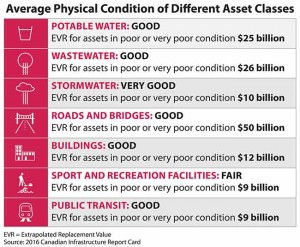
Time to act: 2016 Infrastructure Report Card
By Michael Atkinson
Bridges Concrete Construction Construction Materials Green Construction Infrastructure Roads construction economy infrastructure municipal infrastructure natural resources roadbuilding strategyDecline in municipal infrastructure threatens our quality of life
The modernization of Canada’s core municipal infrastructure is a national challenge. Strong global demand for Canadian products and natural resources will continue to put a strain on our existing infrastructure. Either we strengthen our economy by accelerating the modernization of our existing infrastructure, or we squander what gains we’ve made and fall further behind.
The 2016 Canadian Infrastructure Report Card (CIRC) was published on January 18. While Canadian Construction Association (CCA) applauds the release of the report card, it should sound alarm bells all across the country. In short, municipalities own most of our infrastructure. Nearly one-third of this is in need of repair, and the current levels of reinvestment are inadequate. Waiting any longer will only make the problem bigger, and fixing it more costly. Part of the solution should be a national infrastructure strategy and greater alignment across all levels of government.
Lack of strategy
Municipal infrastructure gets people, and goods moving; provides safe drinking water, handles our waste, creates spaces for sport and recreation, and helps protect our homes against flooding and other natural disasters. It is the foundation that the daily life of Canadians is built upon. The strength of this foundation enables our communities and local businesses to grow, and ensures Canadians have a high quality of life.
As owners of the majority of Canada’s public infrastructure, municipal governments are essential partners in building Canada, identifying and implementing projects that respond to local needs. This includes both responding to new needs caused by population and economic growth as well as the renewal and reinvestment of the existing stock of municipally-owned infrastructure. All local governments, regardless of size face multiple pressures and demands for infrastructure including population growth, climate change and environmental legislation that create new needs and make upgrades to older systems necessary. Despite a renewed commitment to infrastructure by the three levels of government, the impact of unpredictable investment patterns is still felt by municipalities today.
While the physical condition of existing infrastructure remains a concern, there is no question that in Canada there is a significant public infrastructure deficit. The previous edition of the report card published in 2012, Canadian Infrastructure Report Card found the replacement cost for assets rated fair to very poor to be $172 billion. Currently, there is no consistent strategy or alignment across governments in Canada to support infrastructure planning and investments. Inadequate engagement with local governments — which own and manage the majority of Canada’s infrastructure — is a notable gap.
Highlights of the 2016 Report Card
The 2016 Report Card, Informing the Future: The Canadian Infrastructure Report Card, builds and improves on the 2012 report. This year’s report survey assessed the state of municipal roads and bridges, public transit, buildings, sport and recreation facilities, stormwater, wastewater and potable water infrastructure. Some of the highlights from the 2016 report include:
Almost 60 per cent of Canada’s core public infrastructure is owned and maintained by municipal governments. According to survey results, the total value of core municipal infrastructure assets is estimated at $1.1 trillion dollars, or about $80,000 per household.
One-third of our municipal infrastructure is in fair, poor or very poor condition, increasing the risk of service disruption. The survey asked municipalities to qualitatively assess their infrastructure according to a five-point rating scale ranging from very good to very poor. Nearly 35 per cent of assets are in need of attention. Assets in fair, poor and very poor conditions represent a call for action. Survey results demonstrate that roads, municipal buildings, sport and recreation facilities and public transit are the asset classes most in need of attention.
Increasing reinvestment rates will stop the deterioration of municipal infrastructure. The 2016 CIRC found that rates of reinvestment are lower than targets recommended by asset management practitioners. The rate can vary based on factors such as the age of the infrastructure, the level of service and risk tolerance.
The study found that the gap between current and target reinvestment is large enough that it will result in a gradual decline of physical condition levels that will impact municipal services. When contrasted with target reinvestment rates it becomes clear that current levels of reinvestment in municipal infrastructure are inadequate.
Increasing reinvestment rates will save money in the long-term. Without an increase in current reinvestment rates, the condition of Canada’s core municipal infrastructure will gradually decline, costing more money and risking service disruption. Investing in preventive maintenance and regular repair will prolong the asset service life, avoiding premature and costly reconstruction and service disruption.
Building for today’s communities and tomorrow’s Canada requires long-term planning. Survey results demonstrate that, if our current rates of reinvestment do not change, the condition of Canada’s existing municipal infrastructure will decline. A long-term plan is needed to ensure Canadians can continue to rely upon essential public services without disruption.
And finally, all communities, particularly smaller municipalities, would benefit from increased asset management capacity as only 40 per cent of responding municipalities reported publishing a state of infrastructure report (SOIR).
Participants in this year’s survey were asked to qualitatively assess their infrastructure according to a five-point rating scale ranging from very good to very poor. Nearly 35 per cent of assets are in need of attention. Assets in fair, poor and very poor conditions represent a call for action. Survey results demonstrate that roads, municipal buildings, sport and recreation facilities and public transit are the asset classes most in need of attention.
POTABLE WATER: Good (Average physical condition of potable water assets only). The infrastructure in the system or network is in good condition; it is acceptable, generally approaching mid-stage of expected service life. The Extrapolated Replacement Value for assets in poor or very poor condition is $25 billion. The current average reinvestment level of 0.9 per cent annually for linear and 1.1 per cent for non-linear assets will result in a decline in the condition of potable water assets over time.
WASTEWATER: Good (Average physical condition rating of wastewater assets). The infrastructure in the system or network is in good condition; it is acceptable, generally approaching mid-stage of expected service life. The Extrapolated Replacement Value for assets in poor or very poor condition $26 billion. The current average reinvestment level of 0.7 per cent annually for linear and 1.4 per cent for non-linear assets will result in a decline in the condition of wastewater assets over time.
STORMWATER: Very Good (Average physical condition of storm water assets only).The infrastructure in the system or network is in very good condition; it is well maintained, in good condition, new or recently rehabilitated. The Extrapolated Replacement Value for assets in poor or very poor condition $10 billion. The current average reinvestment level of 0.3 per cent annually for linear and 1.3 per cent for non-linear assets will result in a decline in the condition of storm water assets over time.
ROADS AND BRIDGES: Good (Average physical condition rating of road and bridge assets). The infrastructure in the system or network is in good condition; it is acceptable, generally approaching mid-stage of expected service life. The Extrapolated Replacement Value for assets in poor or very poor condition $50 billion. The current average reinvestment level of 1.1 per cent annually for roads and sidewalks and 0.8 per cent for bridges will result in a decline in the condition of these assets over time.
BUILDINGS: Good (Average physical condition rating
of buildings).The infrastructure in the system or network is in good condition; it is acceptable, generally approaching mid-stage of expected service life. The Extrapolated Replacement Value for assets in poor or very poor condition $12 billion. The current average reinvestment level of 1.7 per cent annually will result in a decline in the condition of buildings over time.
SPORT AND RECREATION FACILITIES: Fair (Average physical condition rating of sport and recreation facilities). The infrastructure in the system or network is in fair condition; there are signs of deterioration, some elements exhibit deficiencies. The Extrapolated Replacement Value for assets in poor or very poor condition $9 billion. The current average reinvestment level of 1.3 per cent annually will result in a decline in the condition of sport and recreation facilities over time.
PUBLIC TRANSIT: Good (Average Physical Condition Ratings).
The infrastructure in the system or network is in good condition; it is acceptable, generally approaching mid-stage of expected service life. The Extrapolated Replacement Value for assets in poor or very poor condition $9 billion. The current average reinvestment rate shows that if the trend is maintained, assets will continue to deteriorate.
Do you want to drink water from mains in a “fair” condition?
Efficient, modern core infrastructure enables Canada to be more competitive, create jobs and strengthen our economy. Without adequate infrastructure, business costs will increase and productivity will decrease making Canada less globally competitive.
A modern, well-maintained, efficient national system of core infrastructure is critical to the safety and economic future of all Canadians. Canadians do not want to drink water from water mains that are rated as fair any more than they want to drive on roadways in subpar condition. The 2016 CIRC study found that of the replacement value of the physical condition of the infrastructure assets in very poor and poor condition totals over $140 billion. Simply put, there is no room for fair, poor or very poor when it comes to our infrastructure.
To read the 2016 report card, visit canadianinfrastructure.ca
Article contributed by Michael Atkinson, president of the Canadian Construction Association.
Source: 2016 Canadian Infrastructure Report Card






